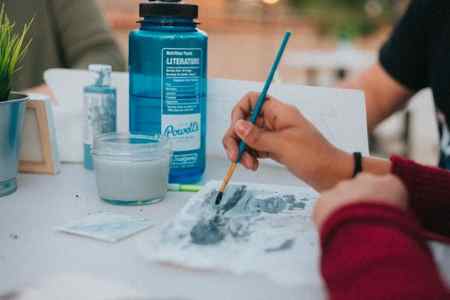The advantage of using Golden OPEN acrylics is you don’t have to don’t have to think about how much retarder to add to the paint. It saves time and prevents you from adding too much.
Five Tips for Painting with Acrylics on Canvas for New Artists
I can teach you how I painted these white abstract flowers on canvas with acrylic paint! I’m teaching step by step flower painting tutorials on Skillshare! If you don’t have a Skillshare account but would like a free 2-week trial membership, join with my link and start learning how to paint today! https://www.skillshare.com/r/user/ellebyers
Here are five tips for artists who are learning how to paint with acrylics on canvas.
1. Colors – Take your time to choose a color palette that you know will work. Get some paint card samples from your local hardware store, or even better, make your own with the paints you have. Choose several colors that you think will work well for your painting and start with those. Referencing the color wheel when you get stuck will be helpful, as well.
2. Brushes – Test a few different brushes to see which ones you like. I typically use filbert, round, and flat brushes in a variety of sizes. You need to figure out which ones work best for you.
3. Underpainting – Paint your canvas one or more colors BEFORE you start your painting. Adding this first layer will help to add depth to your painting. I like to let small pops of my underpainting peek through. A lot of artists start with a red or pink underpainting.
4. Layers – Paint in layers and wait for each layer to dry before adding more paint. It can be annoying to have to wait but you will have a better end result. If you try to layer your paint while it’s still wet you won’t be able to achieve the colors you desire.
5. Practice – If you’re new to painting you might get frustrated. Don’t worry, it takes practice. If you really enjoy painting then just enjoy the process and eventually the results will follow. There are lots of free painting tutorials online that you can watch to pick up new tips and tricks along the way.
Buying Paint
It is best to invest in good quality materials when it comes to acrylic painting. You may be restricted by a budget, but if you invest in good paints and brushes you will save money over time. This is especially a must if you are wanting to sell your work.
Poor quality acrylic paint can often be translucent requiring you to lay down a lot of layers to get an opaque layer of color. For example, a cheap acrylic yellow is notoriously translucent. If you are painting yellow on your painting you will have to paint down multiple layers of the color before it stops showing whatever color or ground is beneath it.
If you are restricted by a budget, the good news is that you do not need a lot of colors right from the start! You could even start with a limited palette (red, blue, yellow, white and burnt umber). If you have a little more money left to purchase more colors you can get 12. However, you will never need much more than that as you will be able to mix your colors to get the specific colors you will need!
Supports – what to paint on

You have a wide range of surfaces available to paint on when it comes to acrylic painting. There is canvas, canvas board, paper, and MDF board.
Cotton – This is what most artists use for their acrylic paintings. It is a popular choice because of its weave and affordability. It can either be stretched over stretcher bars or glued down to a hard wood surface. When using acrylic paints you do not need to prime the surface of cotton canvas. This is because acrylic paint will not seep into the cloth like oil paint does. So, you can just get started right away painting on raw cotton canvas!
Canvas Board – These were initially made for painters to use outdoors. However, some use it consistently in and out of the studio as they are less likely to get damaged than stretched canvas. They are also typically easier to frame than a regular stretched canvas. However, often the surface of canvas boards can be very poor and cheaply made.
Paper – Paper is a great surface to use for acrylic painting! Just like cotton canvas you can apply acrylic paint directly to a paper surface. It can be a good affordable painting surface. Just be sure to get a proper heavyweight watercolor paper.
MDF – MDF board (medium density fiber board) is also a good option for an acrylic painting surface. It is available in most DIY stores. I have purchased some from a lumber store. The downside of this surface is that it can be very heavy. So, when it comes to framing and hanging up a painting… you need strong nails Just be sure to prime the MDF surface.
Keep your Paint Moist

Acrylics dry very fast, sometimes too fast! Especially if you are painting out of doors in a dry climate. If your acrylic paints are drying faster than you would like give your colors a little spray of water from time to time during your painting session. This is one of the best acrylic painting tips and will help to keep your colors moist! You can often find small spray bottles at a drug store, dollar store, or on Amazon!
Just be careful not to add too much water to your paint. Otherwise it might be difficult for the paint to adhere and or it will slough off the canvas. Keep the misting of your paint in moderation.
8 Learn the Basics of Color Mixing
Learning how to mix colors can be frustrating. Beginners often struggle with matching colors and it can be challenging even for more experienced painters.
Color theory is an advanced topic that is not as straightforward and logical as you think it should be.
Therefore, I recommend practicing mixing colors as an exercise in itself. This is a way to break down the components of painting and practicing them separately.

This makes it less frustrating because you’re not trying to learn multiple things at once.
I have a number of videos and posts about how to mix colors but my free acrylic color mixing chart is probably most useful for beginners.
My acrylic color mixing chart contains a number of simple mixtures for the most basic colors. All the color mixing recipes only contain two colors to keep it simple.
The chart includes a variety of ways to mix the same colors using different pigments, depending on what you have available in your studio.
I also have many posts about how to mix some of the more troublesome colors and they all include video demonstrations.

If you’re having problems mixing brown, you may want to read my ultimate guide to mixing brown. I explain how to mix light brown, dark brown, and how to mix brown from primary colors.
Mixing the color of the sky can give beginners trouble. In my post about how to mix sky blue, I head outdoors and I match the color of the blue sky overhead and the lighter blue near the horizon.
Purple can be difficult to mix but I give away my recipes for how to mix vibrant purple. In my post on how to mix bright purple I explain the color theory as to why magenta works better than red when mixing purple.

Below is my full length color mixing demonstration.
The solution is to mix your color to your satisfaction and then add a tiny amount of white to compensate for how it will dry darker.
You can test the color by applying it to scrap of paper and then dry it with a hair dryer. If it matches then you’re done. Otherwise, you’ll have to add more white and dry it and repeat this process until it matches.
I wrote more about this in my post about why acrylic paint dries darker.
Bonus Tip: Use an Easel
If you’re just learning how to paint with acrylics you probably don’t have a dedicated painting studio and an easel.
Many beginners resort to painting at a desk or table.
The problem with this is that it’s not very comfortable. Looking down at your painting for long periods of time puts a lot of strain on your neck muscles.
The solution is to use an easel so that it’s at an angle so you don’t have to look down.
Perhaps you’re putting off purchasing an easel because you think they’re too expensive.


Fortunately, there are affordable easels that work well. I like to use this table top easel that’s built from solid wood (see photo above). It folds flat for storage and it has a drawer underneath for storing some supplies.
Conclusion
Those are my 10 acrylic painting tips for beginners. I hope that these tips will help you to become a better painter amore enthused about painting with acrylics!
Chris Breier
I’m an artist from Buffalo, NY and I enjoy painting with watercolors and acrylics. I have a BFA from the University at Buffalo. My artwork has been featured in The Artist’s Magazine and in books such as the Splash watercolor series and Acrylic Works.





